Study on Heat Utilization in an Attached Sunspace in a House with a Central Heating, Ventilation, and Air Conditioning System
Abstract
:1. Introduction
2. Overview of the Demonstration House and Its Air-Circulation System
3. Numerical Simulation in Winter
3.1. Overview of the Numerical Simulation
- Combined calculation of heat and moisture transfer and airflow;
- Prediction of the hygrothermal environment (temperature, humidity, predicted mean vote, and standard effective temperature);
- Temperature and humidity control or predicted mean vote control;
- Considering the time variation of convective heat and moisture transfer;
- The forced and natural heat and moisture transfer coefficients were calculated for each part based on the dimensionless equation;
- Strict geometric calculation of sunlit and shading areas of the outside and inside;
- Multi-layer window model;
- Multiple reflections of transmitted solar radiation through windows;
- Nonlinearity of radiation heat transfer;
- Mutual radiation between inside surfaces;
- Network airflow model.
3.2. Computation Conditions
4. Results and Discussion
4.1. Verify the Accuracy of the Simulation Software
4.2. Heating Load Reduction Effect by the Attached Sunspace
4.3. Room Temperature Associated with Air Movement within the Sunspace
5. Conclusions
Author Contributions
Acknowledgments
Conflicts of Interest
References
- Lee, H.; Ozaki, A.; Lee, M. Energy saving effect of air circulation heat storage system using natural energy. Build. Environ. 2017, 124, 104–117. [Google Scholar] [CrossRef]
- Babaee, F.; Fayaz, R.; Sarshar, M. The optimum design of sunspaces in apartment blocks in cold climate. Archit. Sci. Rev. 2016, 59, 239–253. [Google Scholar] [CrossRef]
- Bakos, G.C.; Tsagas, N.F. Technology, thermal analysis and economic evaluation of a sunspace located in northern Greece. Energy Build. 2000, 31, 261–266. [Google Scholar] [CrossRef]
- Mihalakakou, G. On the use of sunspace for space heating/cooling in Europe. Renew. Energy 2002, 26, 415–429. [Google Scholar] [CrossRef]
- Lu, S.; Tong, H.; Pang, B. Study on the coupling heating system of floor radiation and sunspace based on energy storage technology. Energy Build. 2018, 159, 441–453. [Google Scholar] [CrossRef]
- Ulpiani, G.; Giuliani, D.; Romagnoli, A.; di Perna, C. Experimental monitoring of a sunspace applied to a NZEB mock-up: Assessing and comparing the energy benefits of different configurations. Energy Build. 2017, 152, 194–215. [Google Scholar] [CrossRef]
- Asdrubali, F.; Cotana, F.; Messineo, A. On the evaluation of solar greenhouse efficiency in building simulation during the heating period. Energies 2012, 5, 1864–1880. [Google Scholar] [CrossRef]
- Chiesa, G.; Simonetti, M.; Ballada, G. Potential of attached sunspaces in winter season comparing different technological choices in Central and Southern Europe. Energy Build. 2017, 138, 377–395. [Google Scholar] [CrossRef]
- Bastien, D.; Athienitis, A.K. Passive thermal energy storage, part 2: Design methodology for solaria and greenhouses. Renew. Energy 2017, 103, 537–560. [Google Scholar] [CrossRef]
- Rempel, A.R.; Rempel, A.W.; Gates, K.R.; Shaw, B. Climate-responsive thermal mass design for Pacific Northwest sunspaces. Renew. Energy 2016, 85, 981–993. [Google Scholar] [CrossRef]
- Rempel, A.R.; Rempel, A.W.; Cashman, K.V.; Gates, K.N.; Page, C.J.; Shaw, B. Interpretation of passive solar field data with EnergyPlus models: Un-conventional wisdom from four sunspaces in Eugene, Oregon. Build. Environ. 2013, 60, 158–172. [Google Scholar] [CrossRef]
- Monge-Barrio, A.; Sánchez-Ostiz, A. Energy efficiency and thermal behaviour of attached sunspaces, in the residential architecture in Spain. Summer Conditions. Energy Build. 2015, 108, 244–256. [Google Scholar] [CrossRef]
- Owrak, M.; Aminy, M.; Jamal-Abad, M.T.; Dehghan, M. Experiments and simulations on the thermal performance of a sunspace attached to a room including heat-storing porous bed and water tanks. Build. Environ. 2015, 92, 142–151. [Google Scholar] [CrossRef]
- Ignjatović, D.; Jovanović Popović, M.; Kavran, J. Application of sunspaces in fostering energy efficiency and economical viability of residential buildings in Serbia. Energy Build. 2015, 98, 3–9. [Google Scholar] [CrossRef]
- Hilliaho, K.; Mäkitalo, E.; Lahdensivu, J. Energy saving potential of glazed space: Sensitivity analysis. Energy Build. 2015, 99, 87–97. [Google Scholar] [CrossRef]
- Zhu, X.; Liu, J.; Yang, L.; Hu, R. Energy performance of a new Yaodong dwelling, in the Loess Plateau of China. Energy Build. 2014, 70, 159–166. [Google Scholar] [CrossRef]
- Sánchez-Ostiz, A.; Monge-Barrio, A.; Domingo-Irigoyen, S.; González-Martínez, P. Design and experimental study of an industrialized sunspace with solar heat storage. Energy Build. 2014, 80, 231–246. [Google Scholar] [CrossRef]
- Aelenei, D.; de Azevedo Leal, H.; Aelenei, L. The Use of Attached-sunspaces in Retrofitting Design: The Case of Residential Buildings in Portugal. Energy Procedia 2014, 48, 1436–1441. [Google Scholar] [CrossRef]
- Chen, Y.; Tong, Z.; Malkawi, A. Investigating natural ventilation potentials across the globe: Regional and climatic variations. Build. Environ. 2017, 122, 386–396. [Google Scholar] [CrossRef]
- Tong, Z.; Chen, Y.; Malkawi, A. Estimating natural ventilation potential for high-rise buildings considering boundary layer meteorology. Appl. Energy 2017, 193, 276–286. [Google Scholar] [CrossRef]
- Oliveti, G.; Arcuri, N.; De Simone, M.; Bruno, R. Solar heat gains and operative temperature in attached sunspaces. Renew. Energy 2012, 39, 241–249. [Google Scholar] [CrossRef]
- Bataineh, K.M.; Fayez, N. Analysis of thermal performance of building attached sunspace. Energy Build. 2011, 43, 1863–1868. [Google Scholar] [CrossRef]
- Ozaki, A.; Watanabe, T.; Takase, S. Simulation software of the hydrothermal environment of buildings based on detailed thermodynamic models. In Proceedings of the eSim 2004 Canadian Conference on Building Energy Simulation, Vancouver, BC, Canada, 10–11 June 2004; pp. 45–54. [Google Scholar]
- Ozaki, A.; Tsujimaru, T. Prediction of hygrothermal environment of buildings based upon combined simulation of heat and moisture transfer and airflow. J. Int. Build. Perform. Simul. Assoc. 2006, 16, 30–37. [Google Scholar]

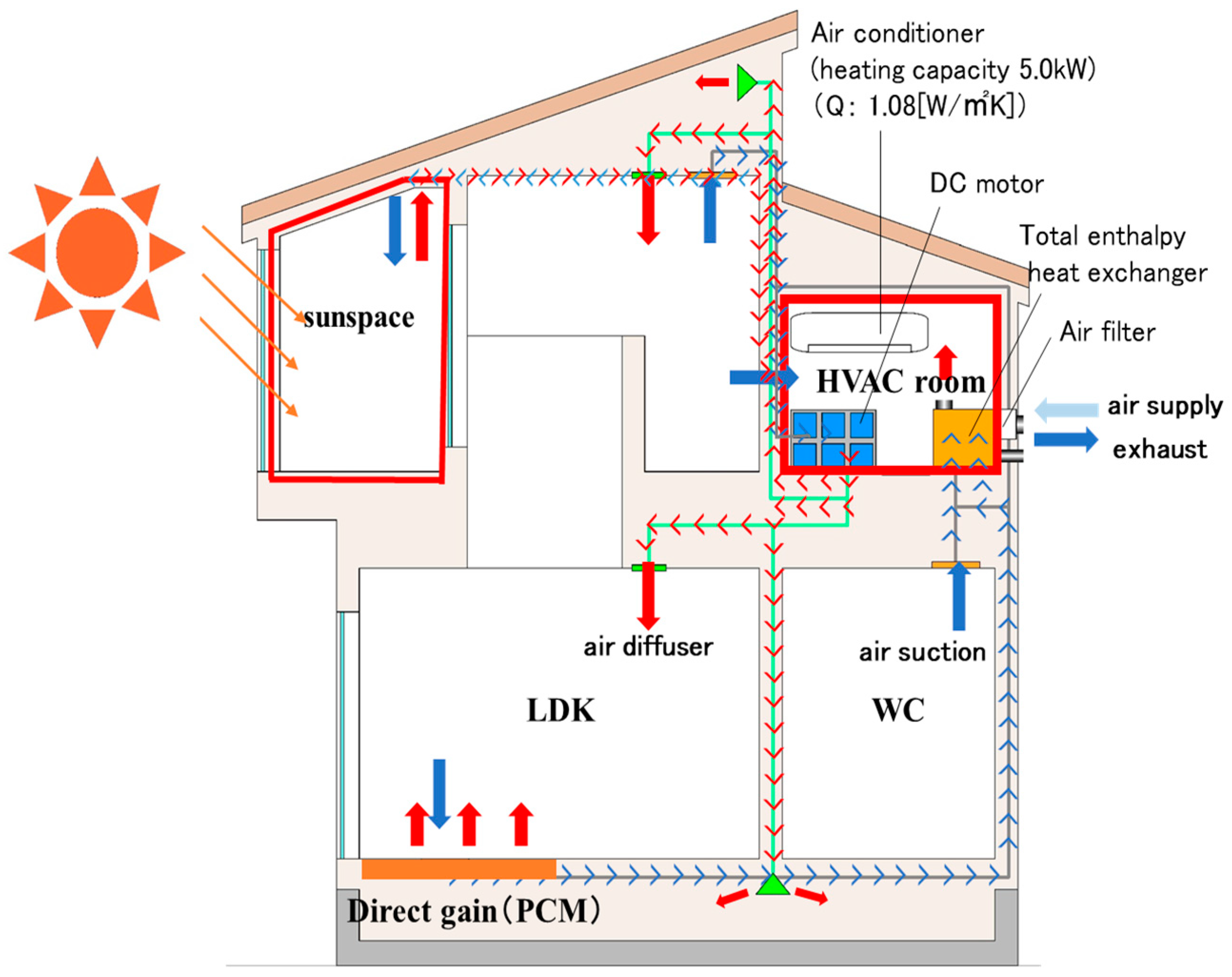
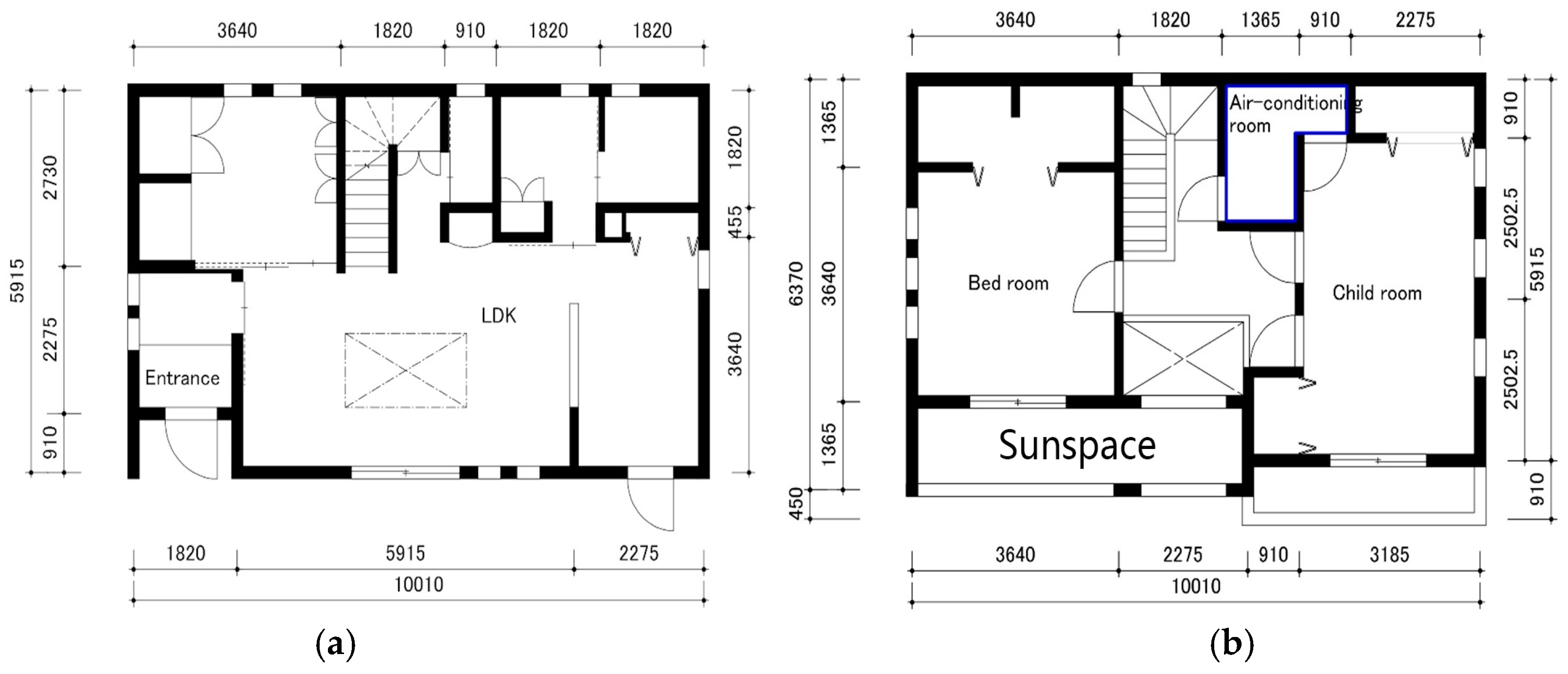
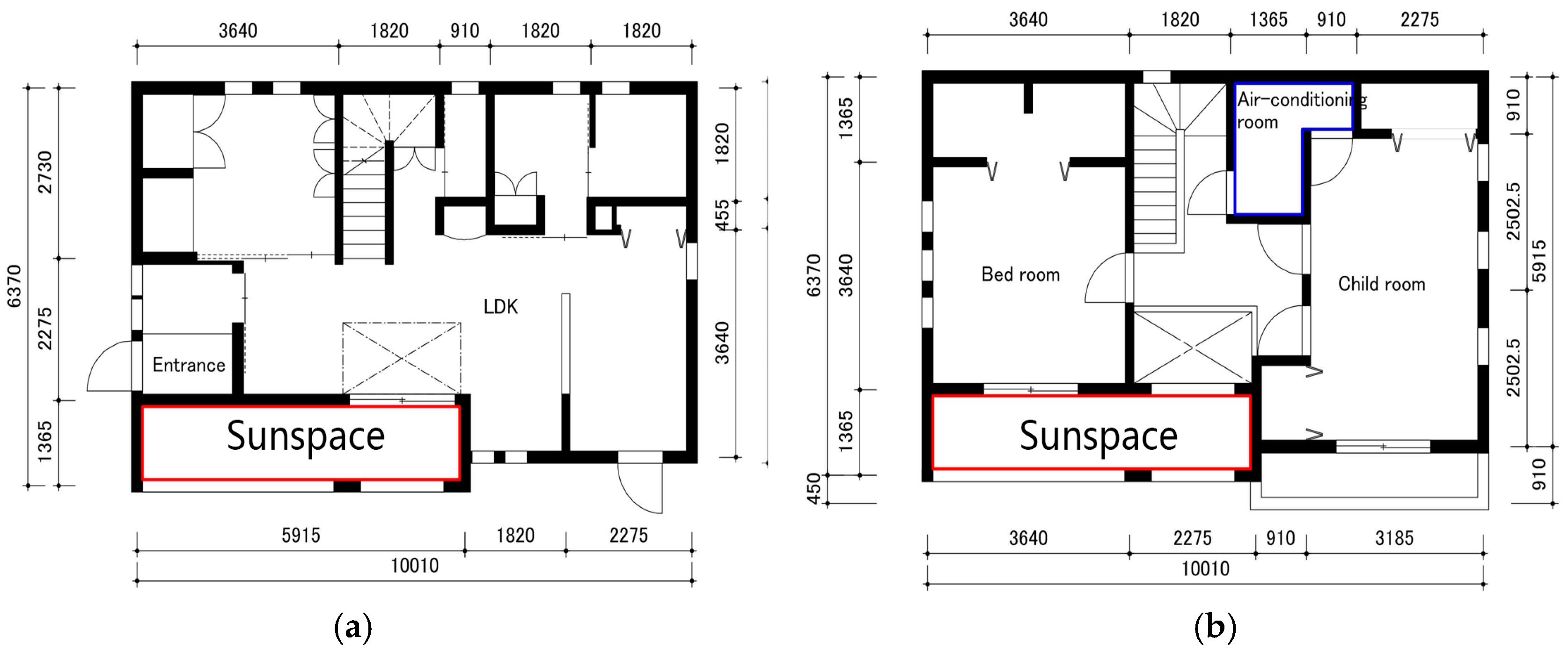




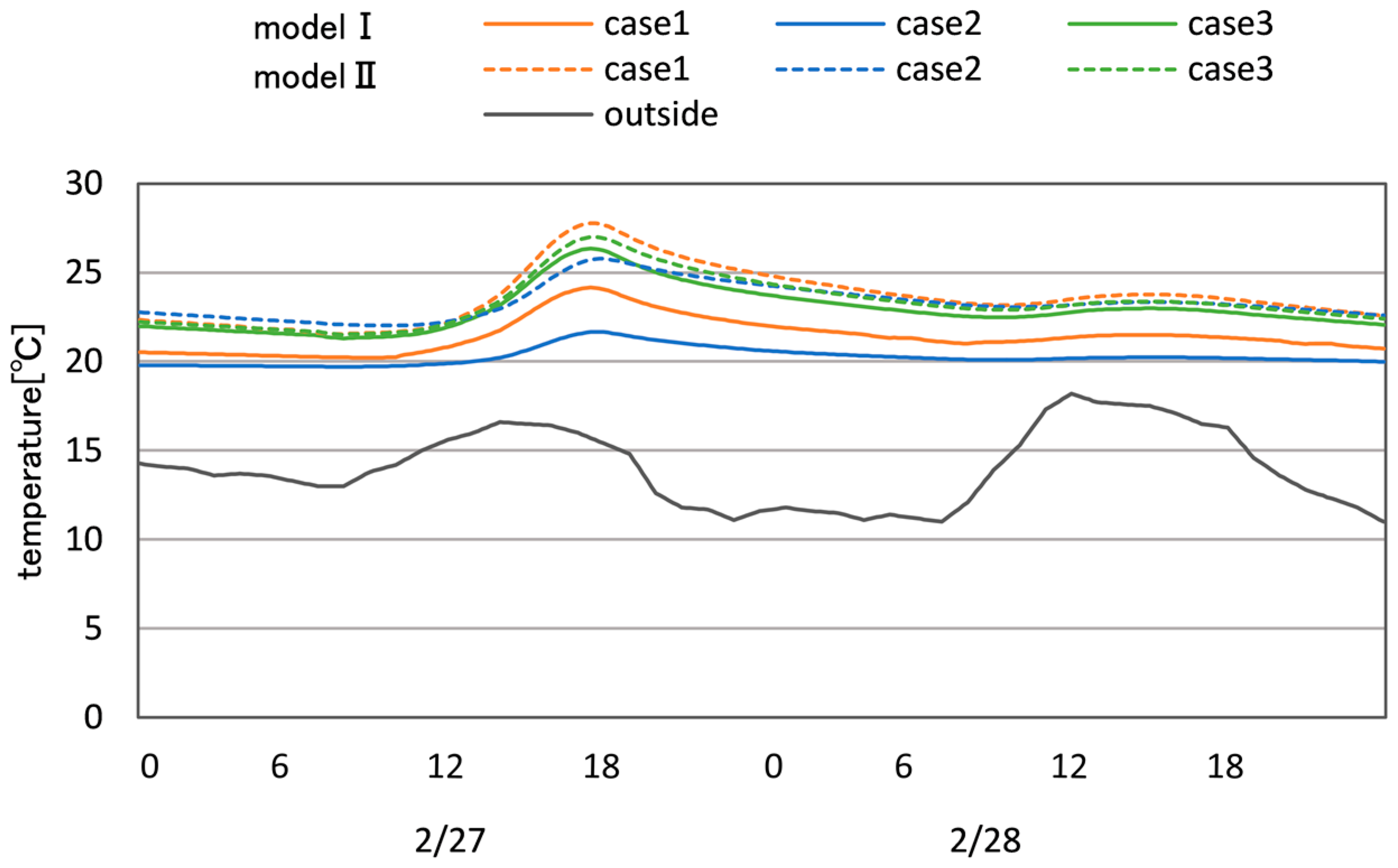
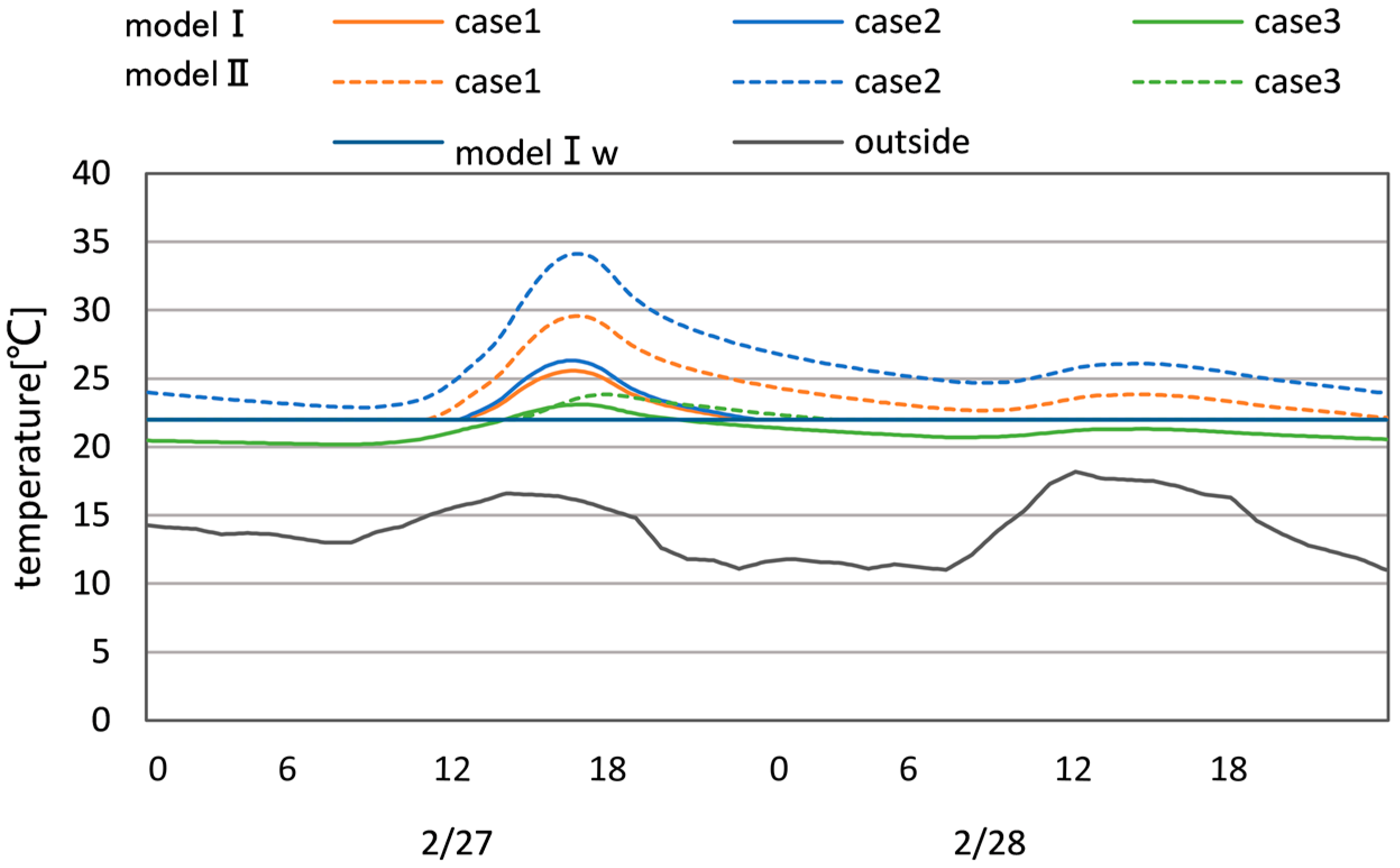

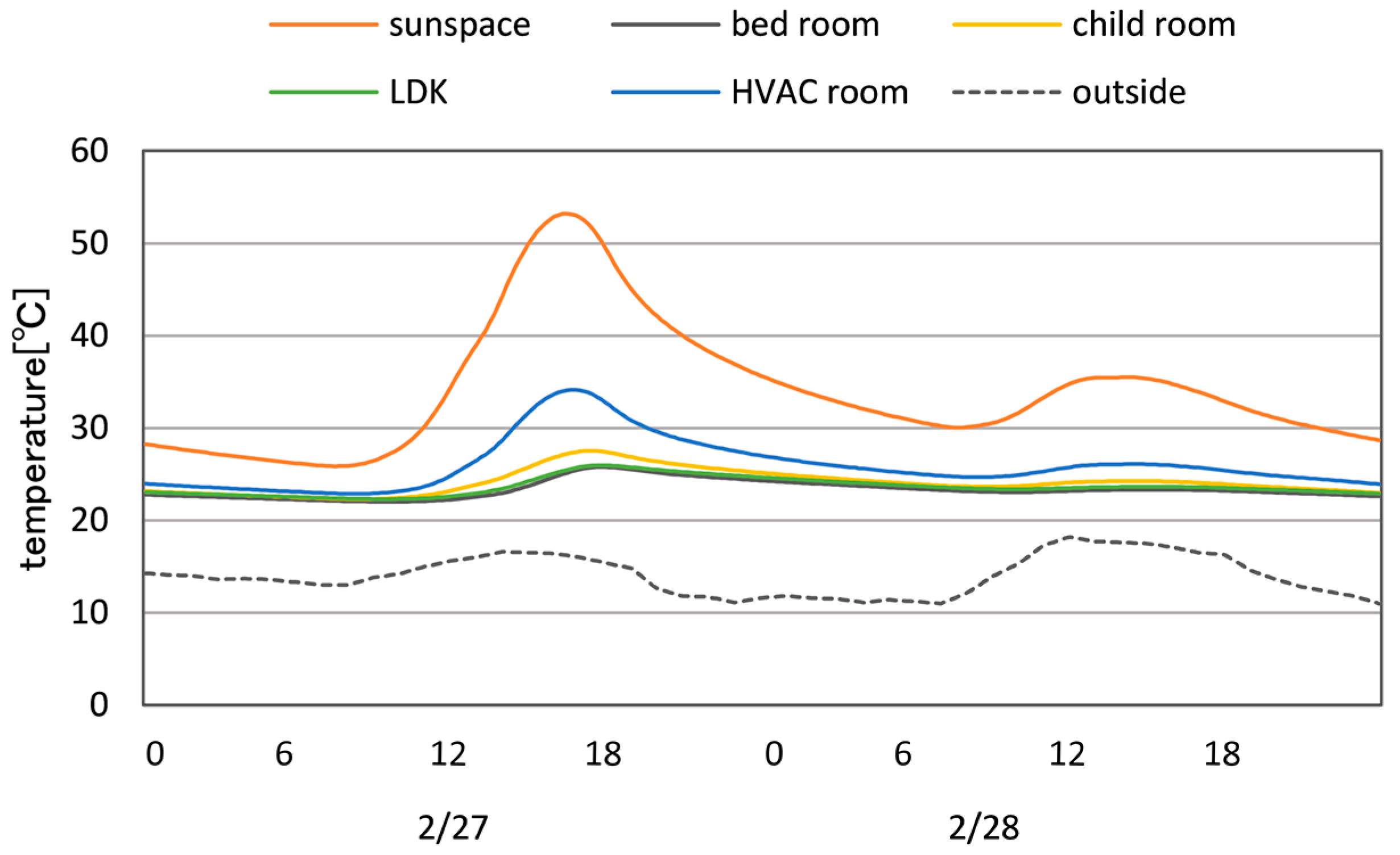
| Location | Miyazaki | |
|---|---|---|
| Orientation | 13.5 degrees southwest | |
| Climate | Hot and humid in summer and cool in winter | |
| Total floor area | 115.5 (m2) | |
| Total building skin area | 350.9 (m2) | |
| Direct gain opening area | 8.1 (m2) | |
| Sunspace opening area | 9 (m2) | |
| Glazing | Sunspace (outside) | Pair glass |
| Others | Triple Shannon IIs | |
| Overall heat transfer coefficient of the skin | 0.26 (W/m2 K) | |
| Air conditioner room | Air-conditioner, DC motor, and the central air-circulation system | |
| Ventilating equipment | Total enthalpy heat exchanger | |
| Computation Area | Miyazaki City |
|---|---|
| Weather data | Expanded AMEDAS Weather Data (Miyazaki, reference year) |
| Computation period | November–March |
| Computation time interval | 10 min |
| Heating method | Central HVAC, all-day heating |
| Heating set temperature | 22 °C |
| Heat generation within a room | Nothing |
| Case | Air Flow from the Sunspace to the Central HVAC Machine Room | Air Flow from the Sunspace to the Adjacent Rooms |
|---|---|---|
| Case 1 | Yes | Yes |
| Case 2 | Yes | No |
| Case 3 | No | Yes |
| Device | Measuring Parameter | Range | Accuracy |
|---|---|---|---|
| RTR-503 | Temperature | 0–55 °C | ±0.3 °C |
| Humidity | 10%–95% | ±5% relative humidity (RH) | |
| Vantage Pro2 Console | Solar radiation | 0–1800 W/m2 | ±5% of full scale |
| Wind direction | 0–360° | ±3° | |
| Wind speed | 0–809 m/s | ±1 m/s | |
| Temperature | −40–+65 °C | ±0.5 °C | |
| Humidity | 1%–100% | ±3% RH |
© 2018 by the authors. Licensee MDPI, Basel, Switzerland. This article is an open access article distributed under the terms and conditions of the Creative Commons Attribution (CC BY) license (http://creativecommons.org/licenses/by/4.0/).
Share and Cite
Ma, Q.; Fukuda, H.; Lee, M.; Kobatake, T.; Kuma, Y.; Ozaki, A.; Wei, X. Study on Heat Utilization in an Attached Sunspace in a House with a Central Heating, Ventilation, and Air Conditioning System. Energies 2018, 11, 1192. https://doi.org/10.3390/en11051192
Ma Q, Fukuda H, Lee M, Kobatake T, Kuma Y, Ozaki A, Wei X. Study on Heat Utilization in an Attached Sunspace in a House with a Central Heating, Ventilation, and Air Conditioning System. Energies. 2018; 11(5):1192. https://doi.org/10.3390/en11051192
Chicago/Turabian StyleMa, Qingsong, Hiroatsu Fukuda, Myonghyang Lee, Takumi Kobatake, Yuko Kuma, Akihito Ozaki, and Xindong Wei. 2018. "Study on Heat Utilization in an Attached Sunspace in a House with a Central Heating, Ventilation, and Air Conditioning System" Energies 11, no. 5: 1192. https://doi.org/10.3390/en11051192
APA StyleMa, Q., Fukuda, H., Lee, M., Kobatake, T., Kuma, Y., Ozaki, A., & Wei, X. (2018). Study on Heat Utilization in an Attached Sunspace in a House with a Central Heating, Ventilation, and Air Conditioning System. Energies, 11(5), 1192. https://doi.org/10.3390/en11051192





